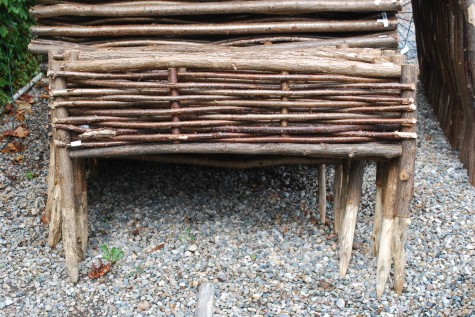Gardeners grow trees, shrubs, annuals, perennials, groundcovers, hardy bulbs, house plants, vines, water plants, herbs, lawn-the list of what they grow is long. They also grow plants to eat-we call this food. Gardeners who grow food on a big scale – for others – are called farmers. The farmers in our country work very long and very hard, and they feed a lot of people, both here and abroad. Before I proceed, I think it is only fair that I be upfront about my biases. As my Mom was a scientist, I was raised with certain notions. “Better living through Chemistry”-this is my era, and my bias.
I am neither proud, nor am I ashamed of this. It just is. She felt that science has helped to make farming more productive. She had a lot of unpopular ideas; scientists frequently do. They have no interest in politics, just good science. They don’t persist, when there is no evidence to warrant persistence. Persistence can get a life of its own, if you don’t watch it. They do not take to readily to fashion, trends, or conclusions.
Some years ago, there was enormous press about how the growth regulator Alar, was in fact a cancer-causing agent invisible to the eye, but present on the apples we bought at the grocery store. In the press we all read – “your apples may be killing you”. Don’t get me started on journalists who read the first paragraph about something, and consider themselves experts, instead of news readers. They need an audience, so they do what they do. It is just too bad they don’t state their bias up front.
Anyway, my Mom fumed about how the ability to measure chemicals in parts per million had created panic where none was needed. You’d have to eat Alar by the pound morning, noon and night to get cancer from it. We are living longer, and better, than we ever have, she said. See the following from the Wikipedia entry on Alar.
Apple growers in Washington filed a libel suit against CBS, NRDC and Fenton Communications, claiming the scare cost them $100M. The suit was dismissed in 1994.
While Alar has been verified as a human carcinogen, the amount necessary for it to be dangerous may well be extremely high. The lab tests that prompted the scare required an amount of Alar equal to over 5,000 gallons (20,000 L) of apple juice per day. Consumers Union ran its own studies and estimated the human lifetime cancer risk to be 5 per million, as compared to the previously-reported figure of 50 cases per million.[4]
Elizabeth Whelan and her organization, the American Council on Science and Health (ACSH), which had received $25,000 from Alar’s manufacturer,[5] worked to establish a narrative of the Alar episode as a scare. The ACSH claimed that Alar and its breakdown product UDMH had not been shown to be carcinogenic. Whelan’s campaign was so effective that today, Alar scare is shorthand among news media and food industry professionals for an irrational, emotional public scare based on propaganda rather than facts. There remains disagreement about the appropriateness of the response to Alar, but as of 2005 it is classified as a probable human carcinogen by the IARC and the EPA and a carcinogen by the U.S. State of California.[5]
She also thought a good bit of any given person’s chance at longevity had to do with their specific genetic makeup. She was a scientific fatalist-and I guess I have a dose of that too. Farmers get help with insect and disease control so they can sell their food at prices people can afford. Everyone needs to eat-and I will place special emphasis on the concept-everyone needs to eat.
Organically grown food is incredibly labor intensive. Small organic farmers have an equally small ability to distribute. This makes the food expensive. I see plenty of organic food that does not appear to be fresh. I like home grown corn and tomatoes as much as the next person-I eat these foods every day, in season. I buy from local farmers at the Oakland County Farmers Market in Pontiac. I buy from Farm Boy Market. I don’t ask them what chemicals they use to grow their crops. I just try to thank them for growing good food that I can afford to eat. Organic milk, produce, and meat-a luxury.
I read, and I keep up with the news. I have read all of Michael Pollan’s books-ok, fine. It seems perfectly reasonable that if you eat the foods your grandparents ate, you are eating in a healthy way. But the article by Judy Gunlock from the National Review, “Alice in Wonderland”, caught my eye. It articulates far better than I ever could my feelings on this subject of organically grown food. http://www.nationalreview.com/articles/227303/alice-wonderland/julie-gunlock
Organically grown food is very expensive food. It is also cool food; food as fashion. Righteous food. As for those people that eating amounts to a religious experience-I am glad the organic farming people have customers for what they sell. I eat to live, and get my religious experiences elsewhere. Being an adult has lots, maybe too many responsibilities. But one of its perks is being able to decide what I want to eat. I make no recommendations to others about how and what they should eat. I only comment that planting, making things grow, and being aware of my connection to the natural world, has provided me with a satisfying and healthy life-for what that’s worth.
There is no science or study which conclusively proves that people suffer and die too young from food grown with the labor-saving help that science provides. There is no scientific study which suggests that organically grown food makes people more healthy. I would hazard to say that people in our country have a good financial opportunity to eat as well as any place on the planet. The topic of organically grown food bores me beyond all belief, as the topic is always accompanied by the emphatic assertion that it is better food. That if I would just come to my senses, I would realize that this opinion was more than just an opinion. My opinion? Righteousness is a concept appropriate for church.
Just designing an experiment which will prove or disprove a theory is very difficult-as you have to track and account for every variable. I celebrate the whole idea of variability. This means that lots of people have lots of opinions about what is good and right. Everyone is entitled to their opinion, but an opinion is not a fact. Every gardener has their own way of growing, and most of those ways work for them. There’s no need for my way to work for you, unless you decide you want to give it a try. In every garden, in every neighborhood, in every city, in every country, planet wide, there are people gardening, eating healthy-in many different ways-that still are living to tell the tale.
Yesterday I drove by the Charles L. Bowers School Farm; both shoulders of Square Lake road were jammed for a good quarter mile with families taking their kids to the farm. In 25 years, I personally have never met a child of a client who did not know that potatoes are grown in the ground, that peaches come from trees, and milk comes from cows. I myself still remember visiting the Michigan State University dairy experiment station in their school of agriculture, to learn about milk production-that was 50 years ago.
I am sure Alice Waters is a very fine chef. She has an aura generated by popular opinion and fashion. One is led to believe she is a guru-chef, a rock star chef, the first and the last word about righteous food. I think she needs to get out into her own country more-just as Judy Gunlock suggests. I would ask her to consider the idea that maybe what tastes good and is healthy is much about what we each imagine tastes good and is healthy. I could offer her a good meal anytime, or direct her to any number of other local households that serve great meals. She is talented, colorful, and convincing. Would I include her in a list that included Einstein, Curie, Pasteur, Newton and DaVinci- no. Would I want her to be in charge of research that would help feed our plant? No. Do I think she is interested in the challenges posed by the need to feed the planet-no.
My last word on this topic is that it is very important work, to feed the multitudes. No kidding, Judy Gunlock; the purpose of food is to nourish people. People of all different environments and circumstances. If your circumstances enable you to have dinner at Alice Water’s restaurant, fine. I would want that she be able to keep cooking. People who eat there make it possible for her to keep cooking. Who knows what she will have to say or cook in 10 years.
For all of you gardeners, if the idea of organic food still appeals to you, grow it yourself. I am the last person who would fault your effort. If you are so inclined, figure out how you can provide yourself with organically pure soil. Plant a columnar apple tree in your yard, if your space is small. Asparagus looks great planted between the roses, after you are done harvesting the spring crop. Strawberry jars were invented for a reason. Tomatoes like tall pots for their long root runs, thus we have “long tom” pots. Certain tomato varieties do well in hanging baskets. Plant your vegetables and herbs in pots filled with righteous and pure soil on your terrace. Spring pots of peas and lettuce look good, and taste good-spice up those pots with some pansies. Your local nursery can help with all of this, until you get up the nerve to grow your own food from seed. Making something grow is good in every regard. But the need to persuade everyone within your reach to grow how you think it should be grown just might be speaking out of school.
The food I buy at my farmer’s market, and at my grocery store, is good, affordable and fresh food. I’ve lived 63 years, and according to my internist, I’m healthy. This is good enough for me. What is good enough for you? That is your choice, not mine.
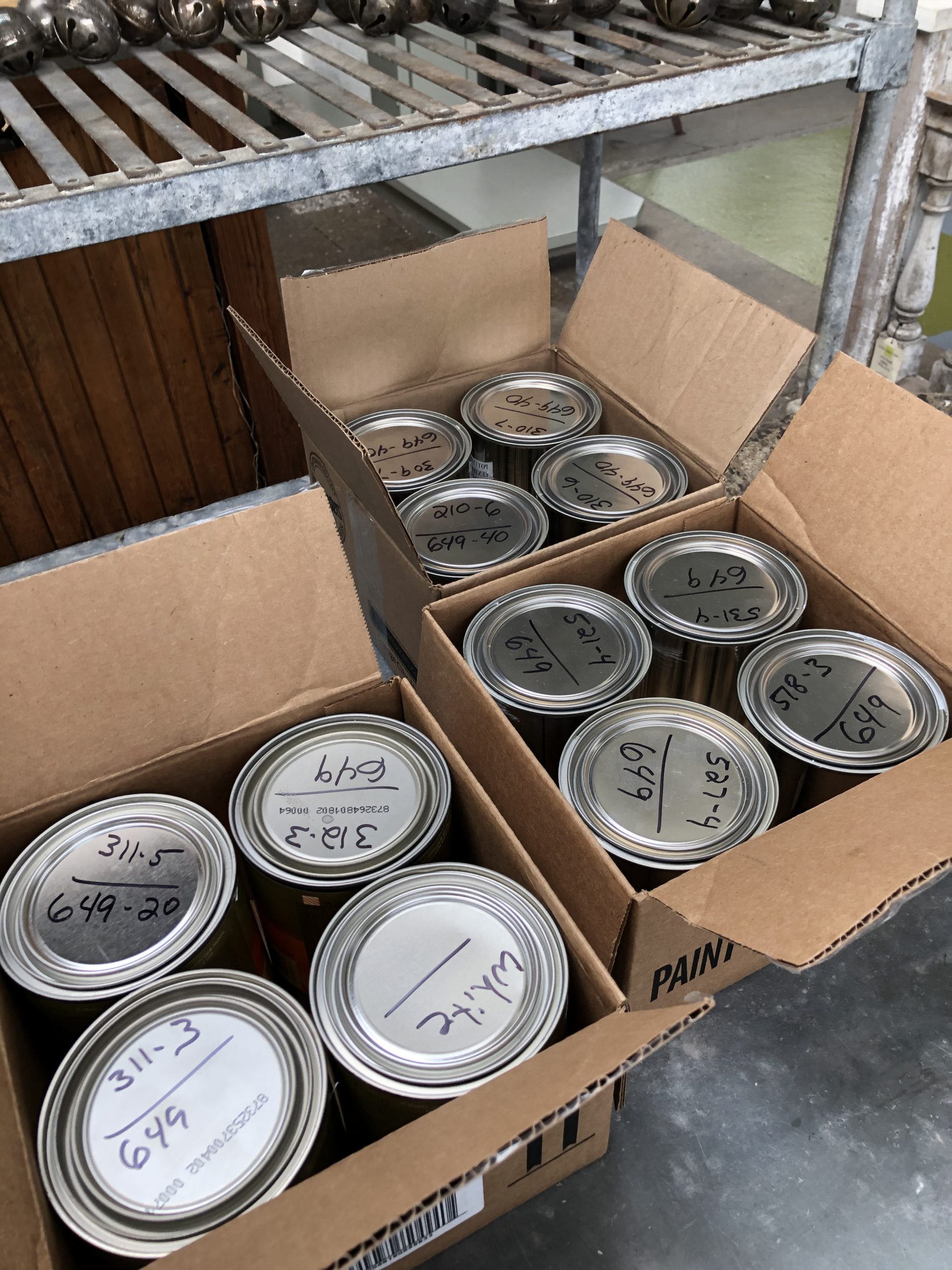
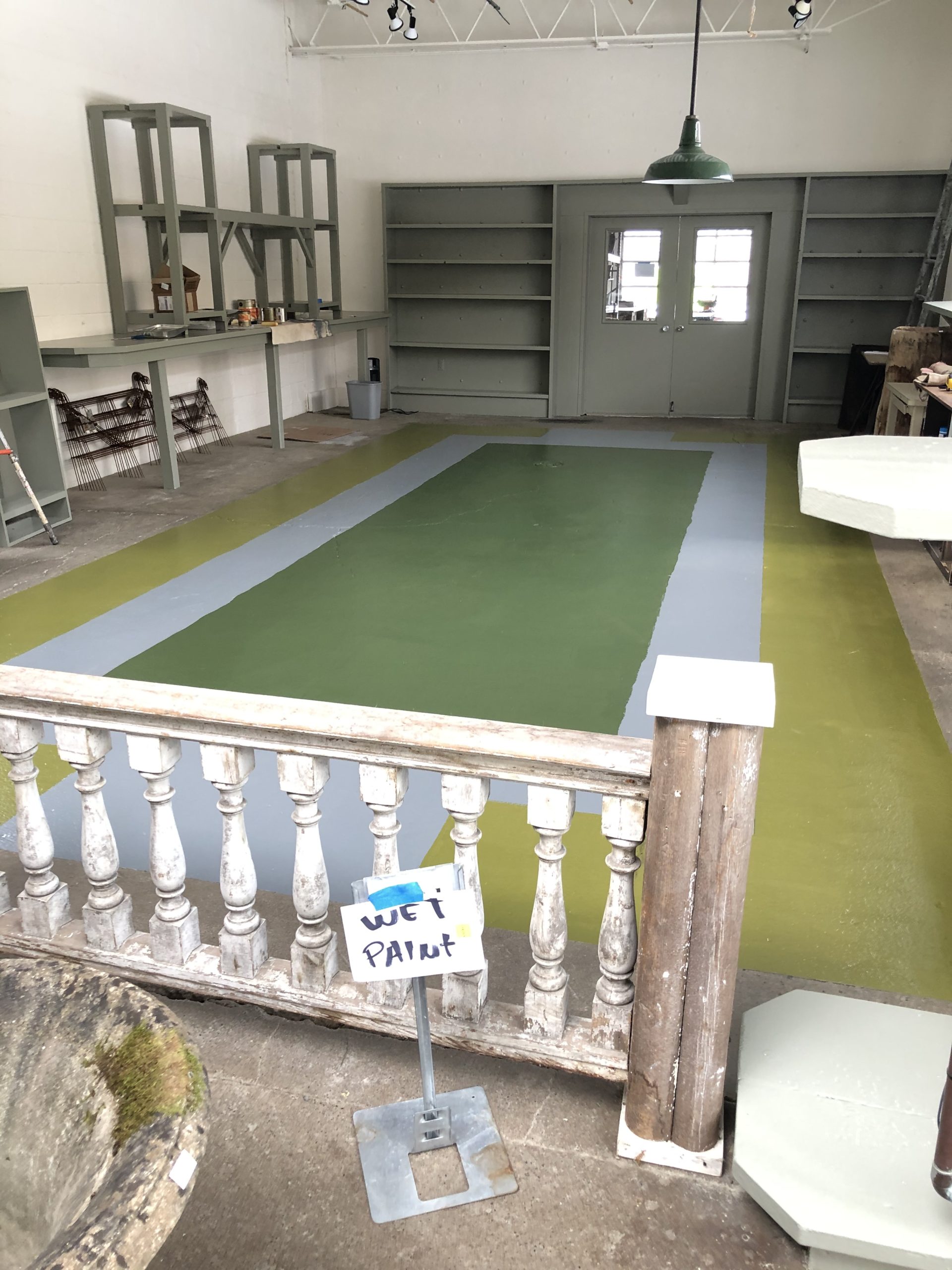
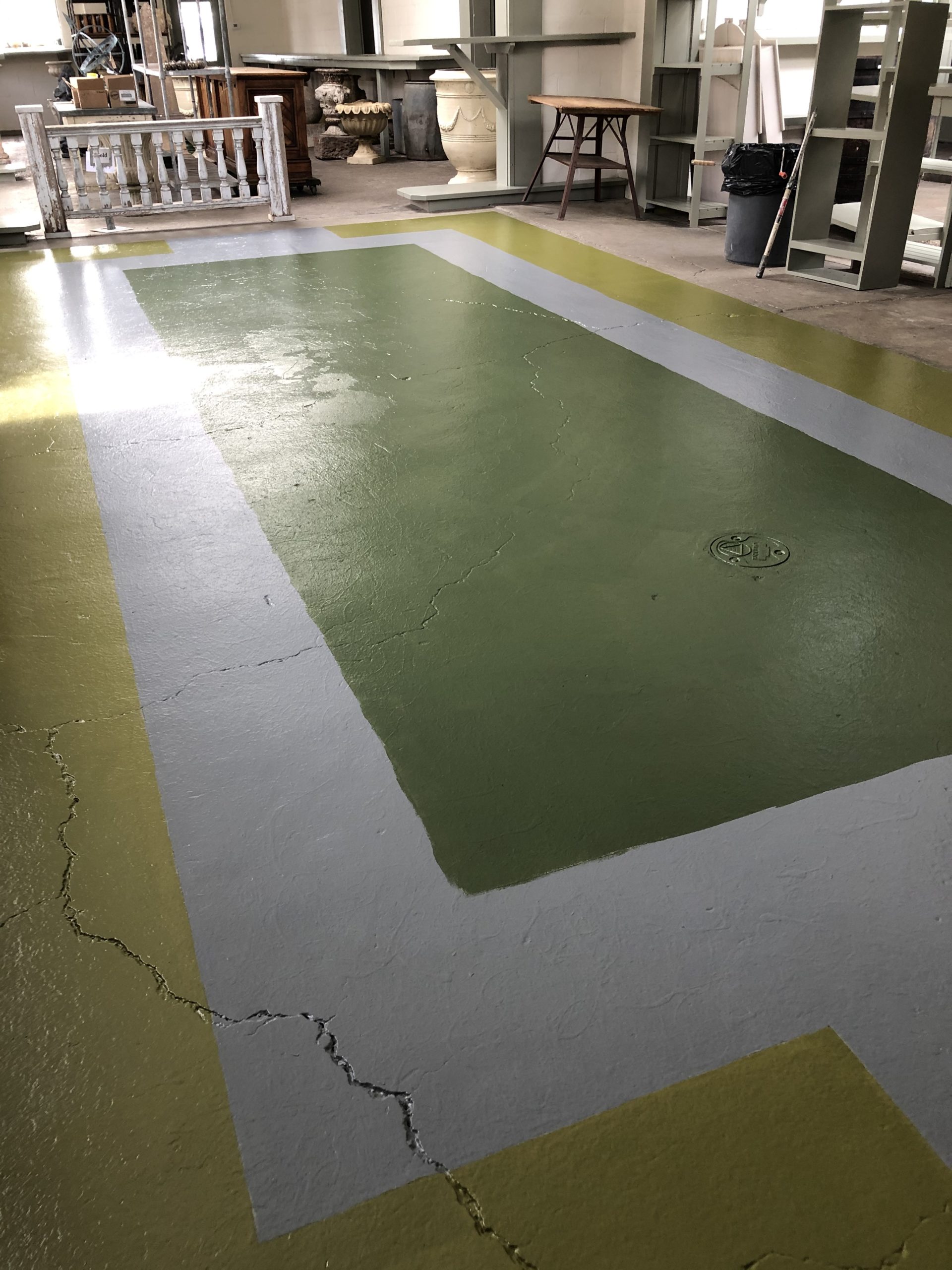 This picture clearly shows the largest area of wear sustained by the previous floor. Part of our concrete block wall sprung a leak, and water had been sitting in this spot on and off for several years. The rest of that floor was in remarkably good condition. I ascribe that in total to the quality of the paint. Porter Paint, routinely used by sign painters, comes in a 100% acrylic formula which hardens much more than latex paint. Owned by PPG, Porter’s exterior Acri-Shield paint is exceptionally durable and comes in a vast number of colors. It is eminently strong enough to use as a floor paint. Happily, one of a few paint stores in Michigan that carries this paint is near us. See more about this great paint store here:
This picture clearly shows the largest area of wear sustained by the previous floor. Part of our concrete block wall sprung a leak, and water had been sitting in this spot on and off for several years. The rest of that floor was in remarkably good condition. I ascribe that in total to the quality of the paint. Porter Paint, routinely used by sign painters, comes in a 100% acrylic formula which hardens much more than latex paint. Owned by PPG, Porter’s exterior Acri-Shield paint is exceptionally durable and comes in a vast number of colors. It is eminently strong enough to use as a floor paint. Happily, one of a few paint stores in Michigan that carries this paint is near us. See more about this great paint store here: 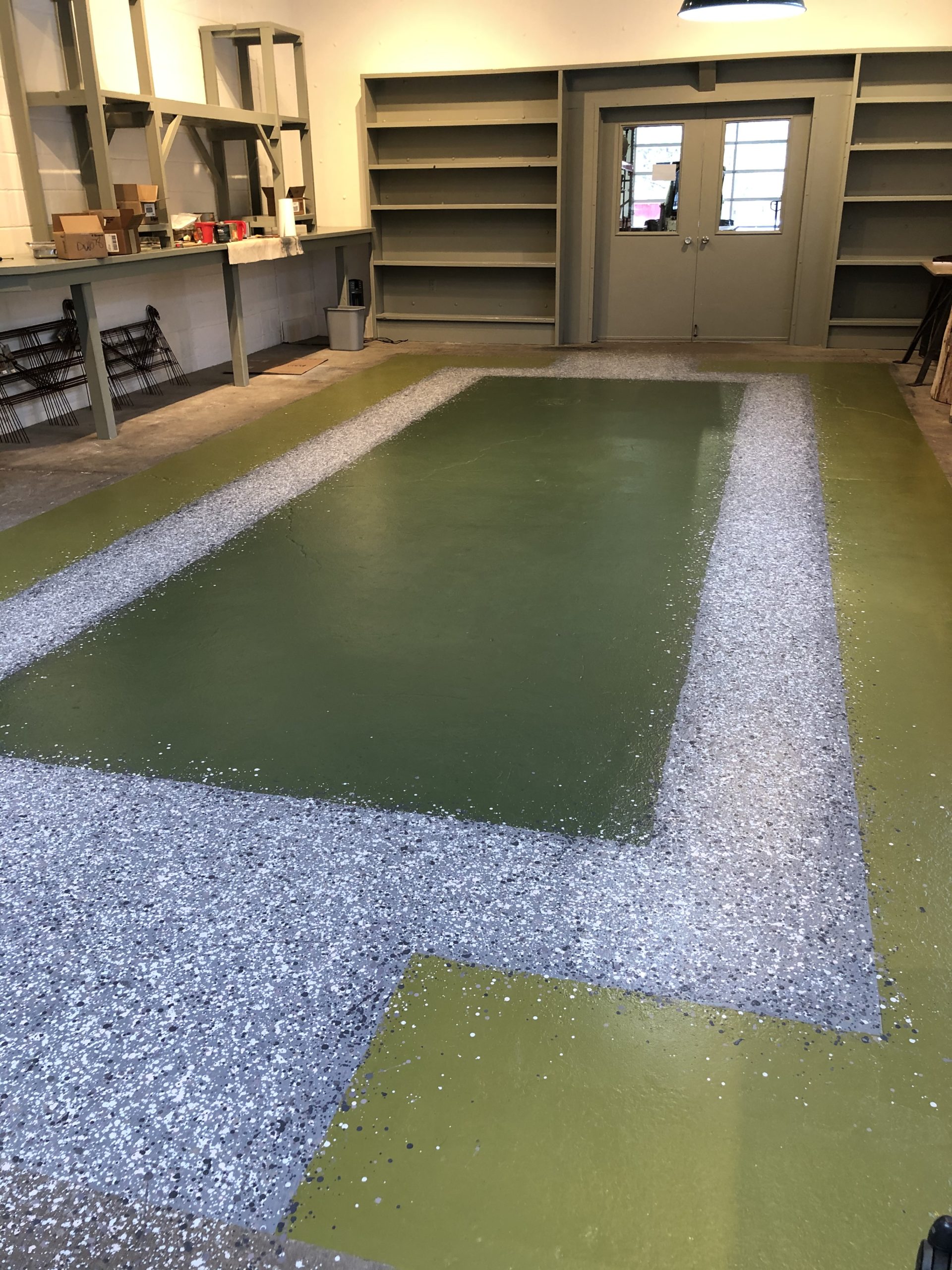 The floor would have but a few elements. A grassy plane, admirably described by the French as a “tapis vert”, is as elemental a garden as any. And it is the starting point for any number of more elaborate expressions. That green square is a prominent part of the logo for the Works. In additional to the green plane, there would be a surrounding gravel path, and a planted area marked by large leaves to enclose that gravel. Painting the gravel was the first order of business, as plants from both sides would likely overlap onto it.
The floor would have but a few elements. A grassy plane, admirably described by the French as a “tapis vert”, is as elemental a garden as any. And it is the starting point for any number of more elaborate expressions. That green square is a prominent part of the logo for the Works. In additional to the green plane, there would be a surrounding gravel path, and a planted area marked by large leaves to enclose that gravel. Painting the gravel was the first order of business, as plants from both sides would likely overlap onto it.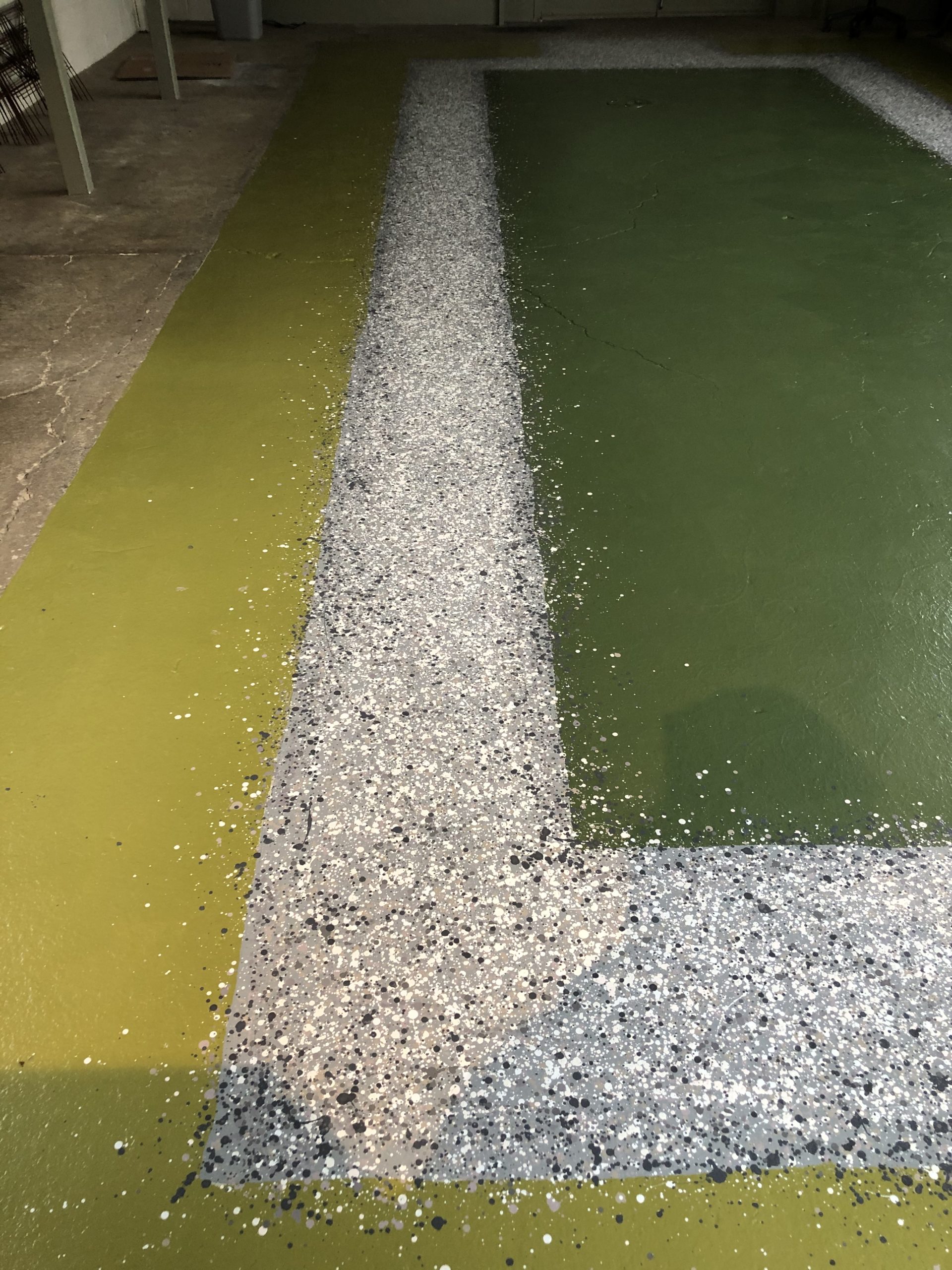 This would be the easiest part of the painting. A series of colors would be dripped on to the floor surface from a wood plant marker. The only finesse to this part would be slowly thinning the paint so it would drip at a reasonable rate-not too slow, and not too fast. Of course there was plenty of wrist and shoulder action, so the drips would be spaced out.
This would be the easiest part of the painting. A series of colors would be dripped on to the floor surface from a wood plant marker. The only finesse to this part would be slowly thinning the paint so it would drip at a reasonable rate-not too slow, and not too fast. Of course there was plenty of wrist and shoulder action, so the drips would be spaced out.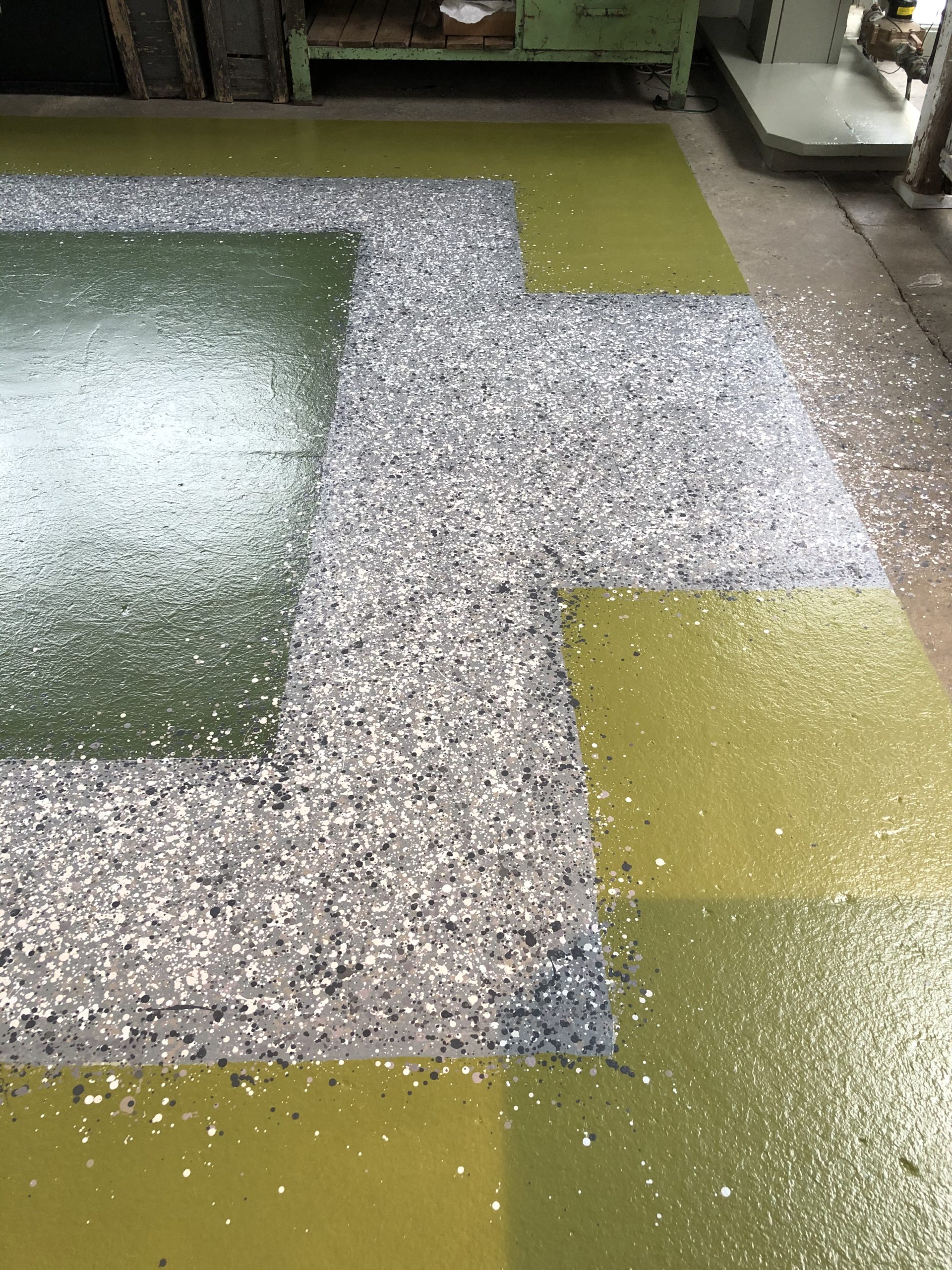
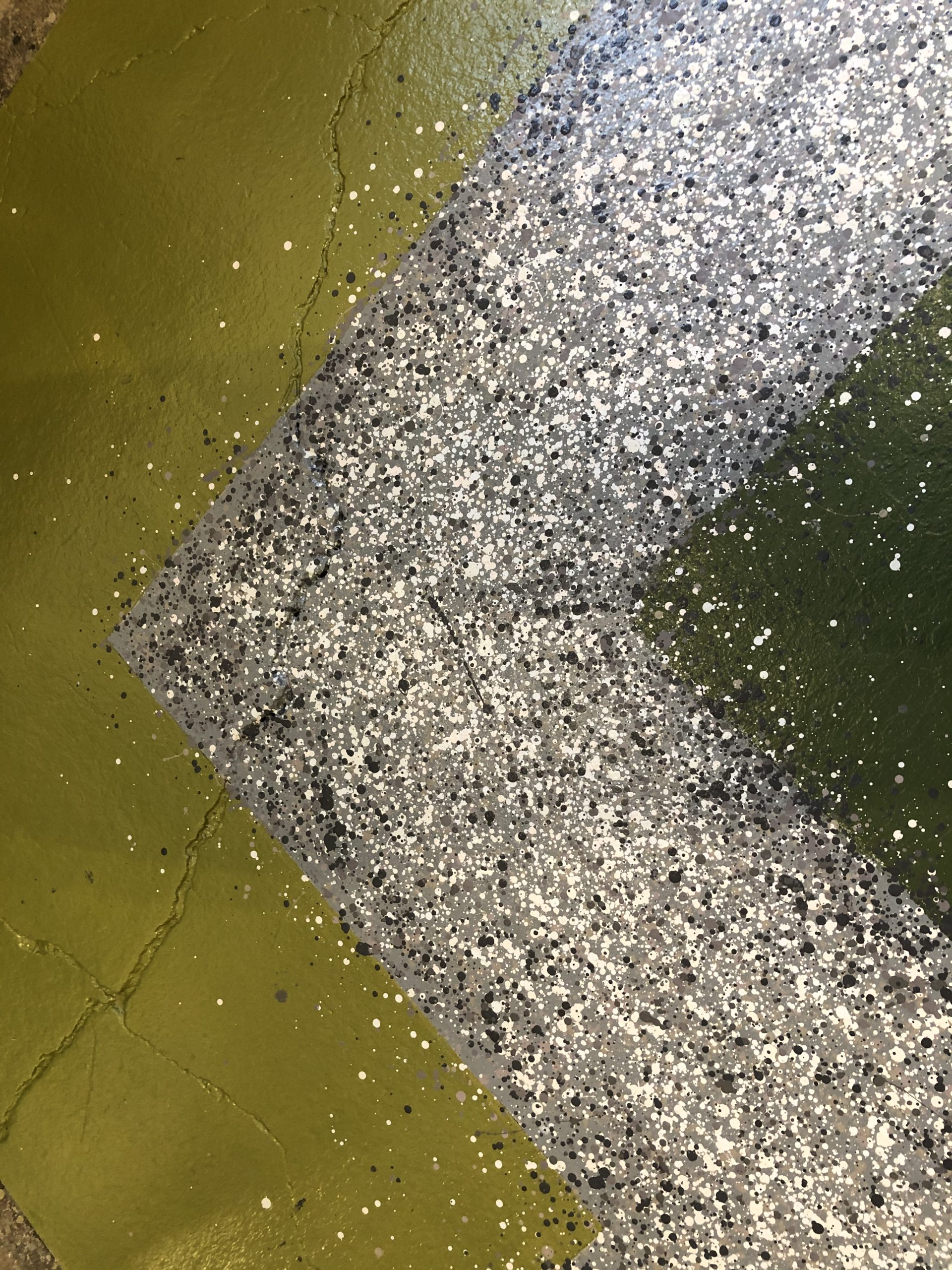 Some effort was made to keep the gravel darker and less detailed on the edges. Once the leaves to come were painted over the edges, that would help create a little sense of depth. This is decorative painting-not fine art. But a nod to composition and technique gives the mural a little more polished look.
Some effort was made to keep the gravel darker and less detailed on the edges. Once the leaves to come were painted over the edges, that would help create a little sense of depth. This is decorative painting-not fine art. But a nod to composition and technique gives the mural a little more polished look.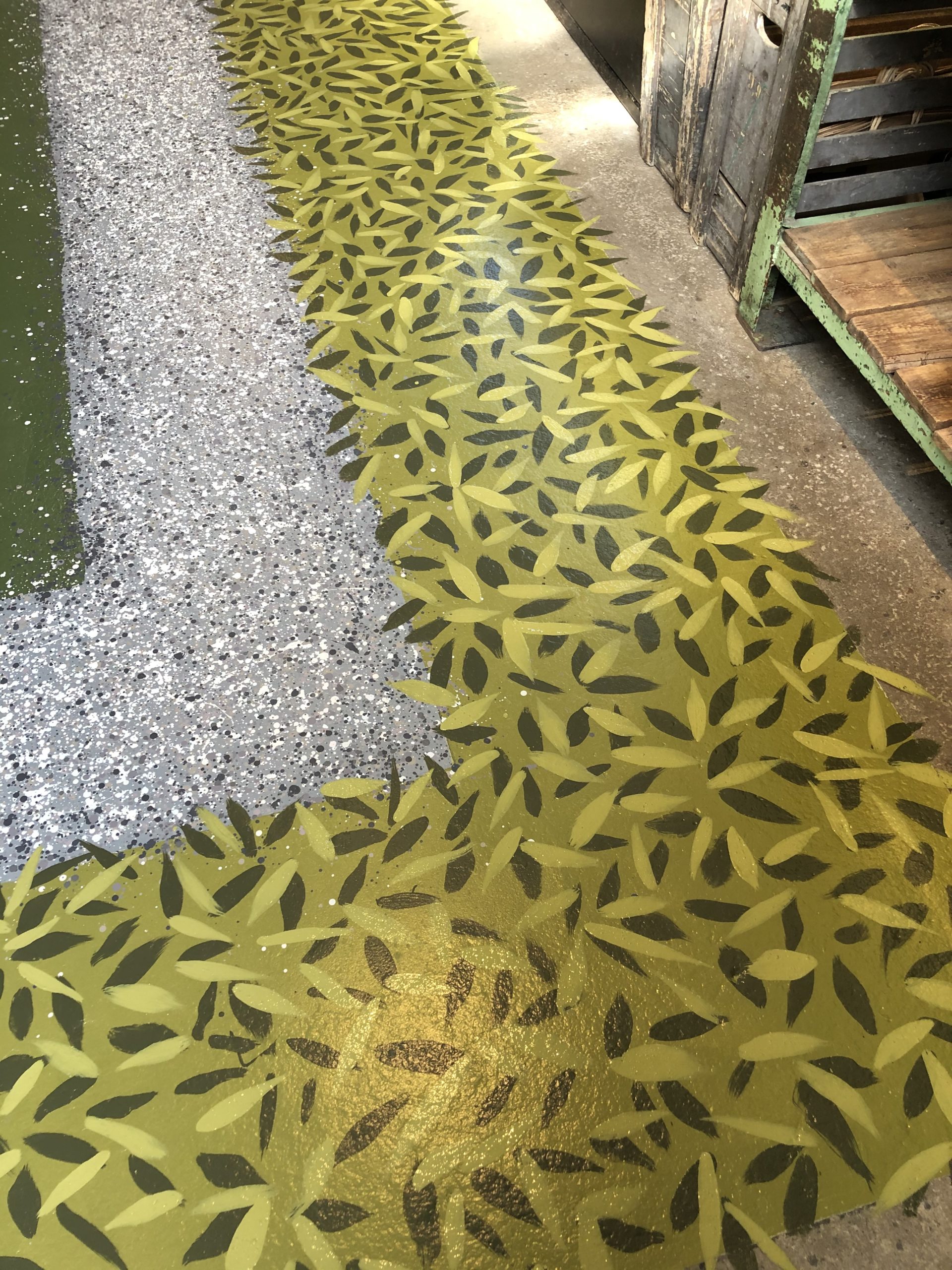
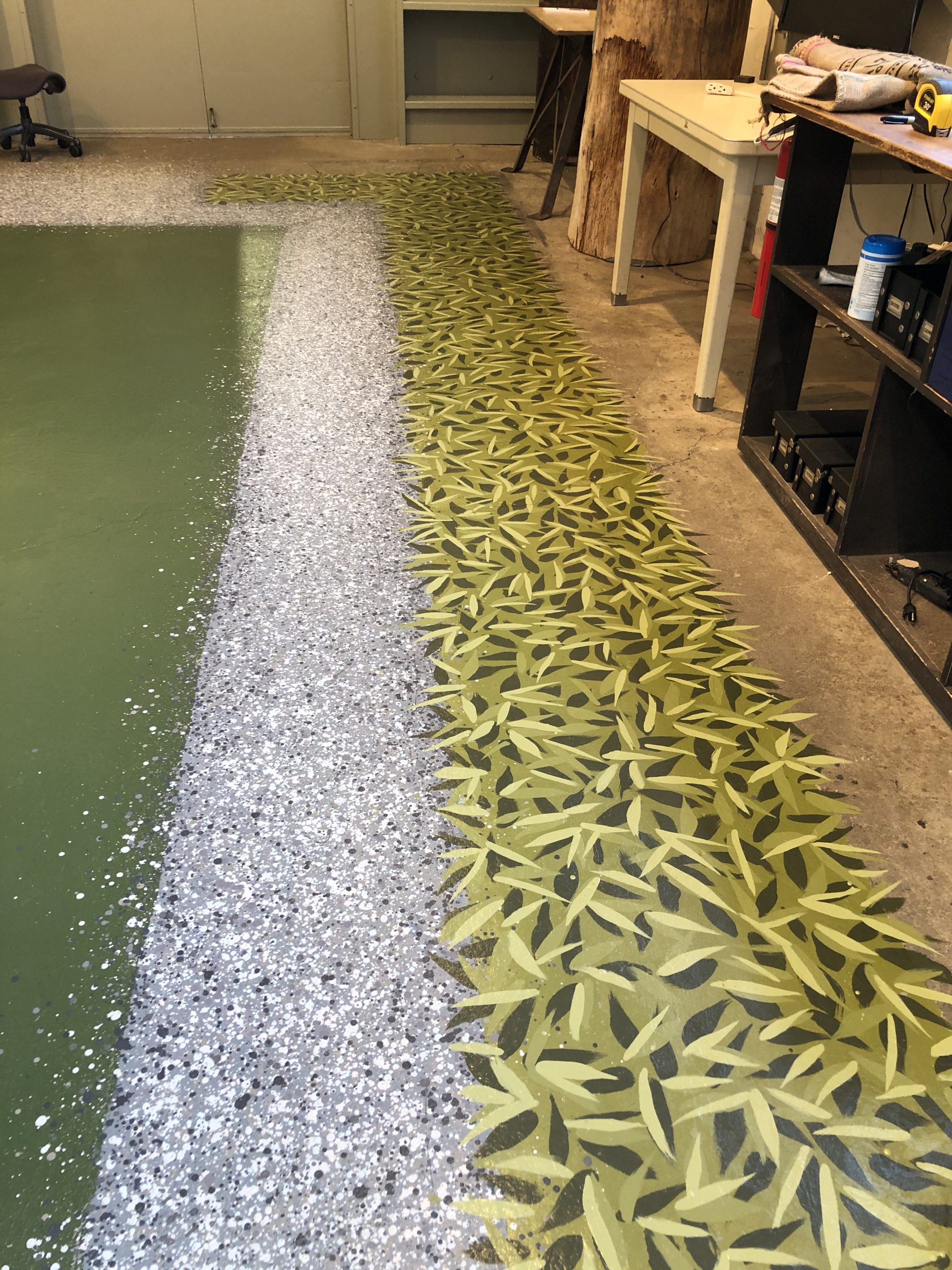
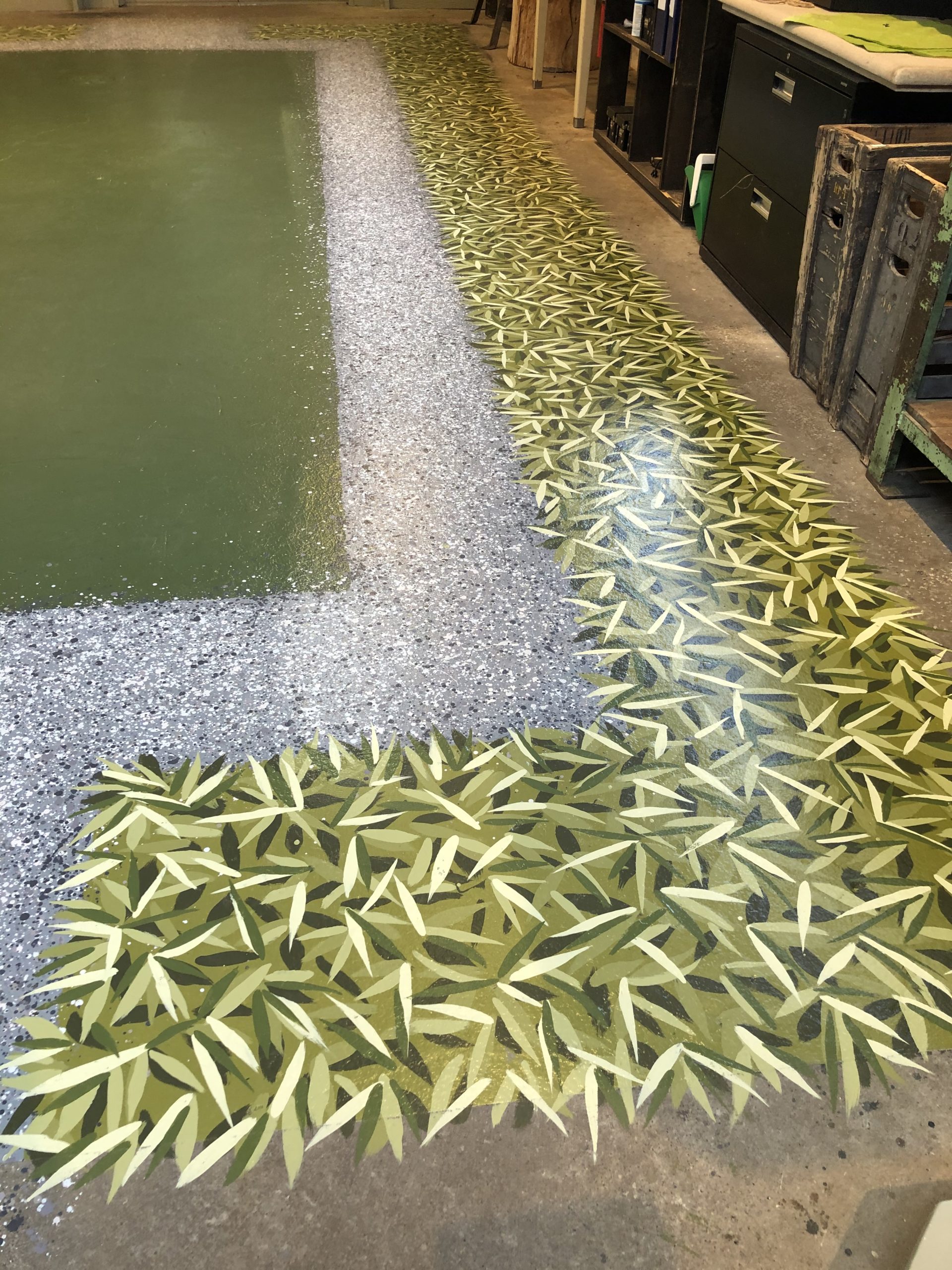
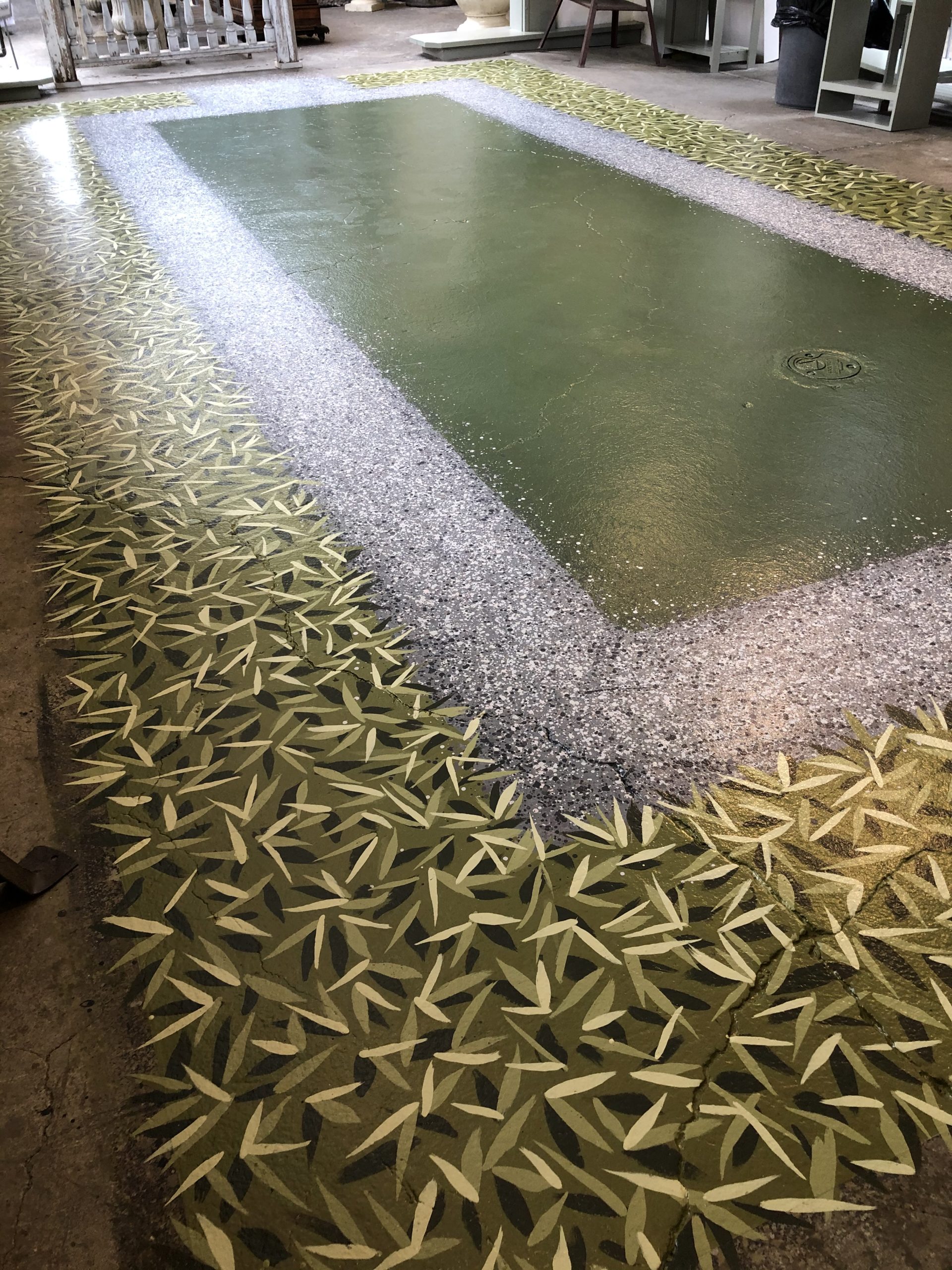
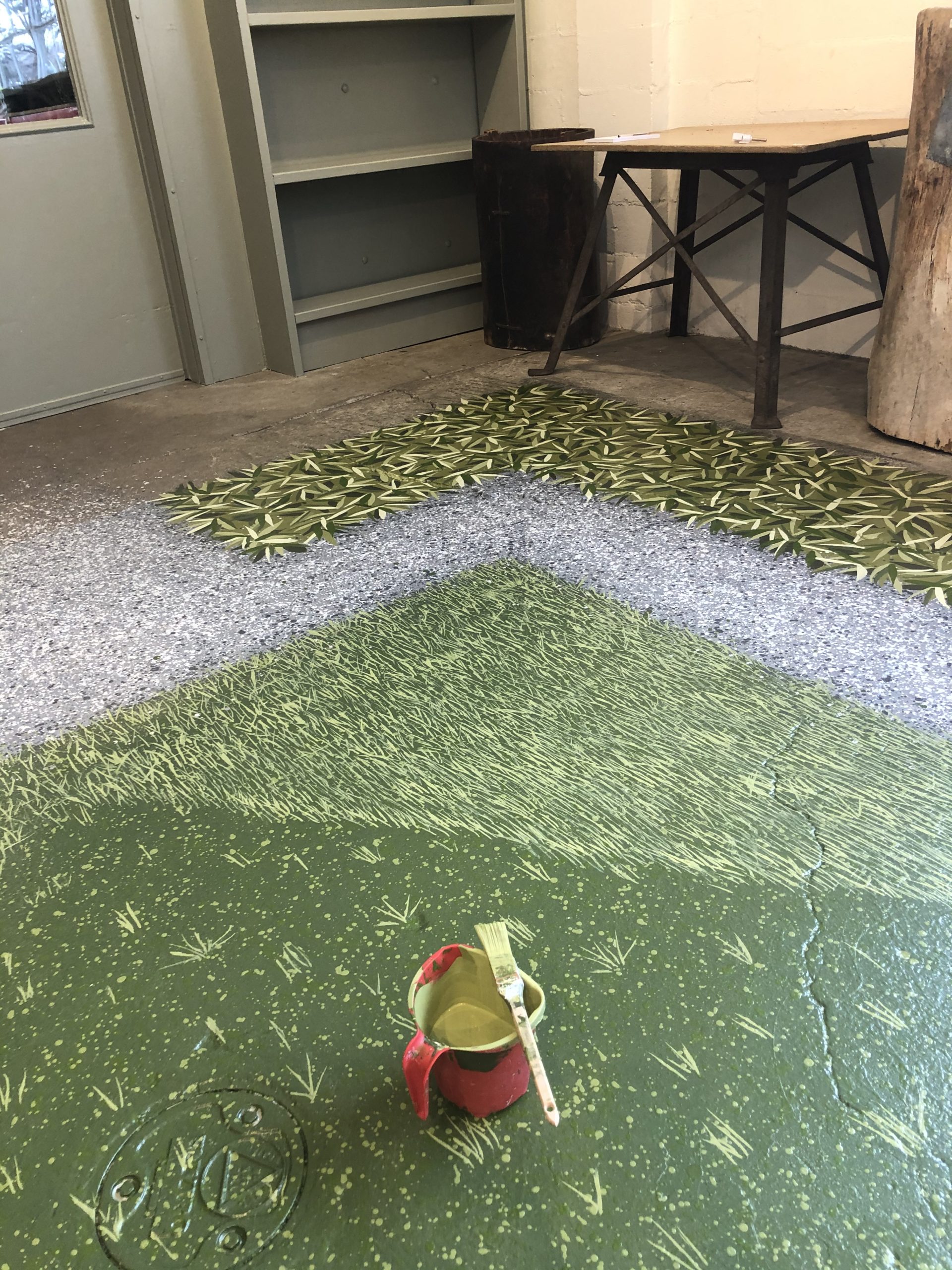
 Those marks were very lively. They brought the dark center up to the same visual plane as the gravel. Eventually I settled in to the job, and two days later that portion was finished.
Those marks were very lively. They brought the dark center up to the same visual plane as the gravel. Eventually I settled in to the job, and two days later that portion was finished.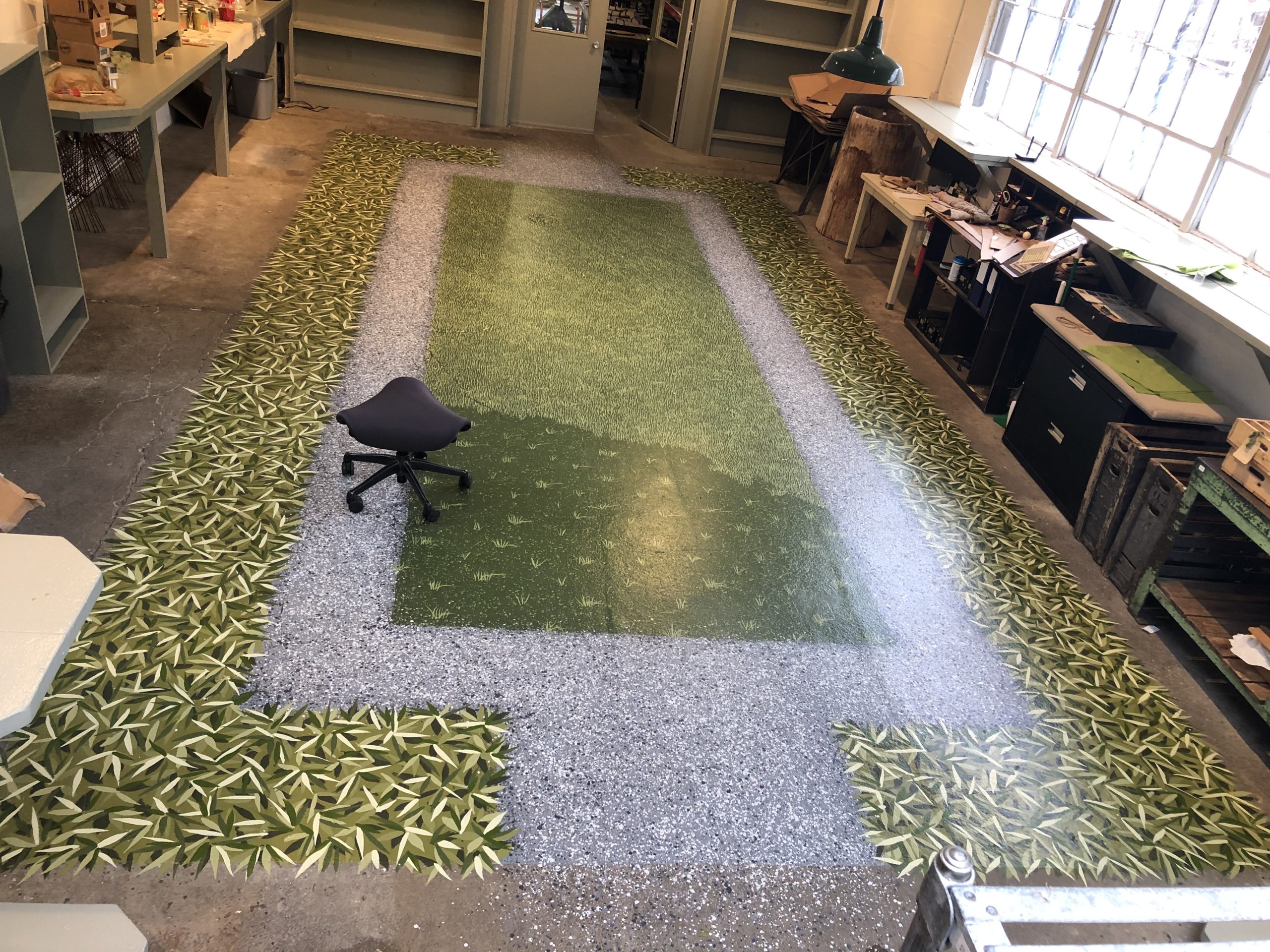

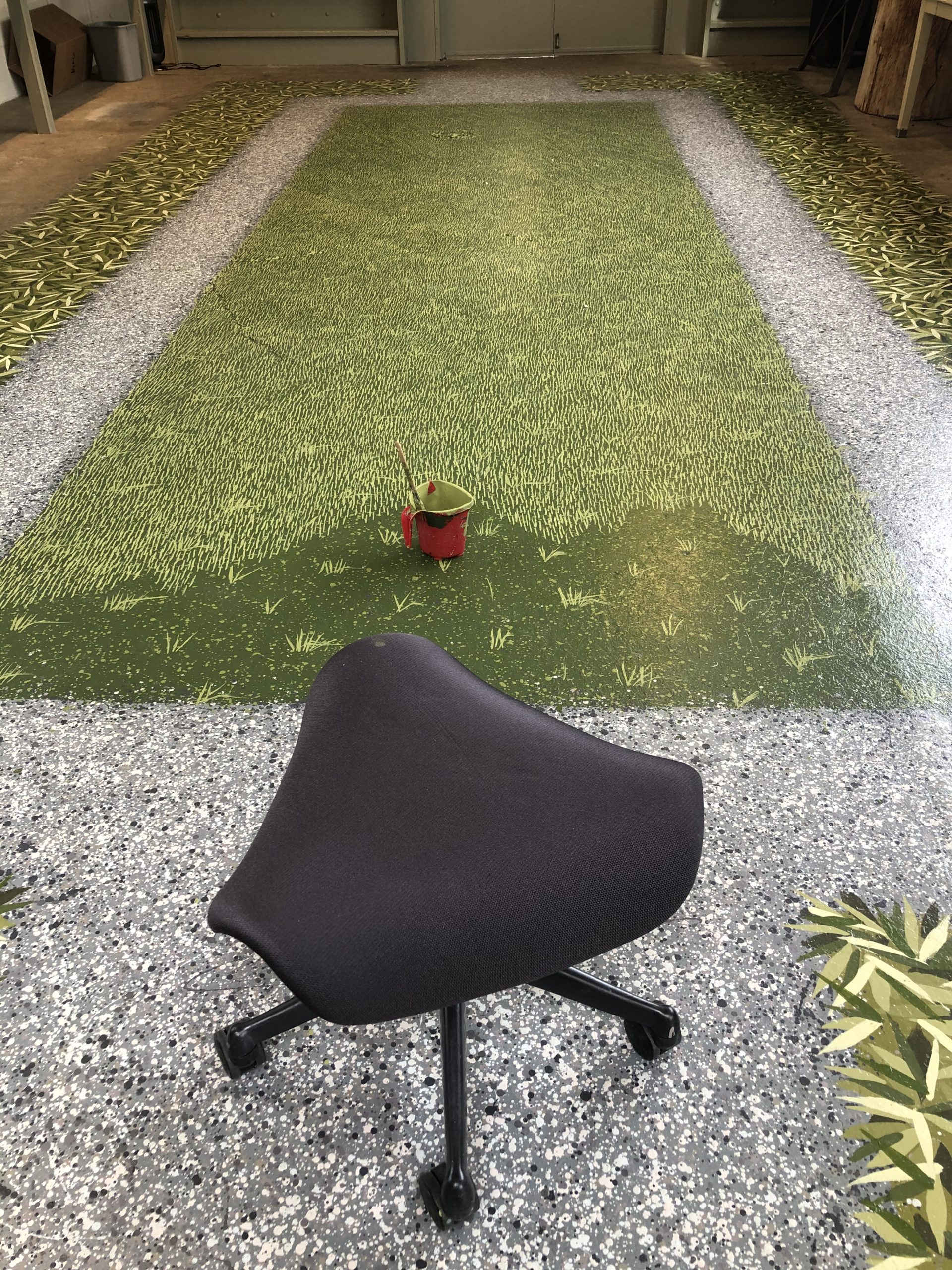
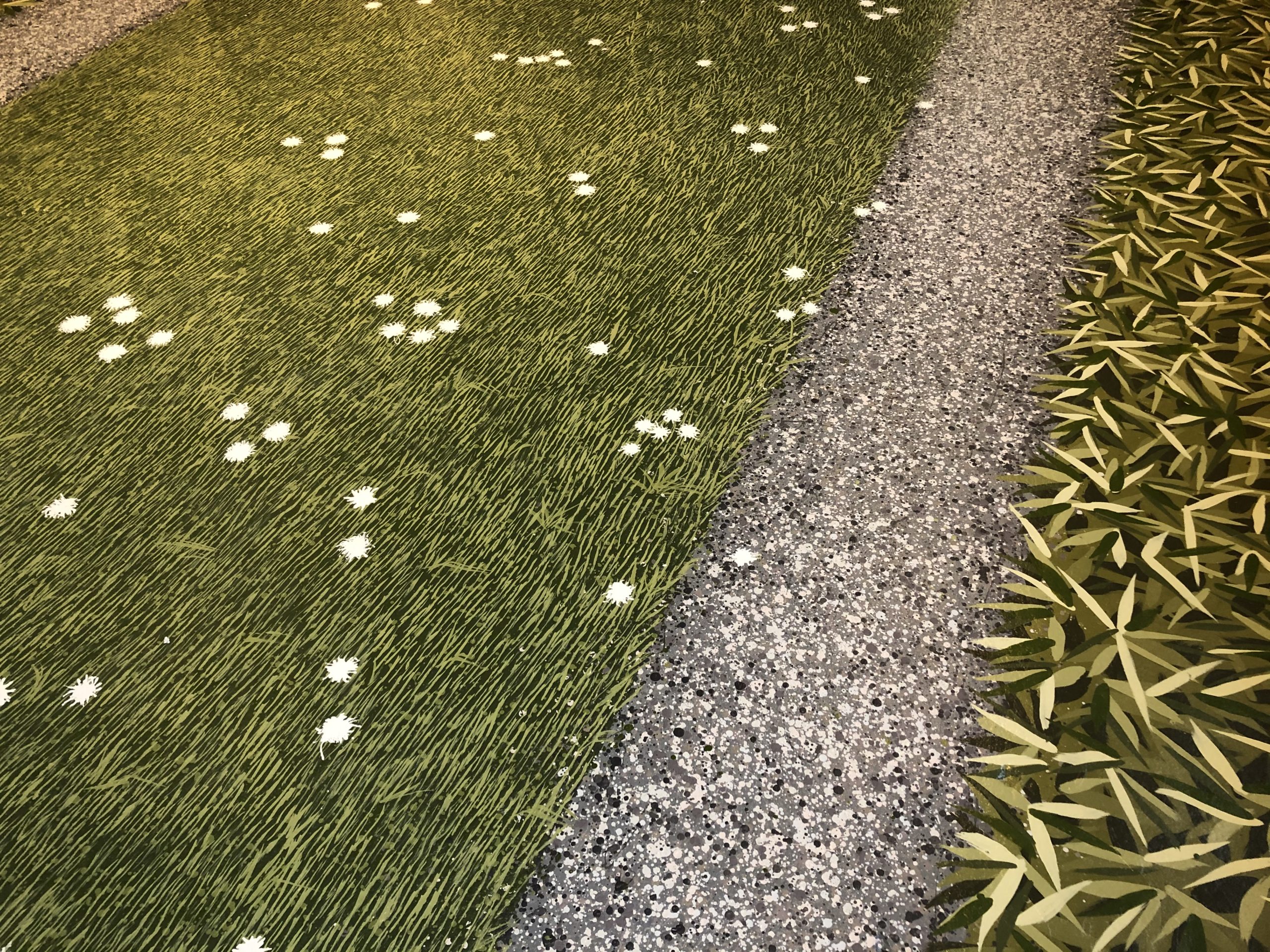
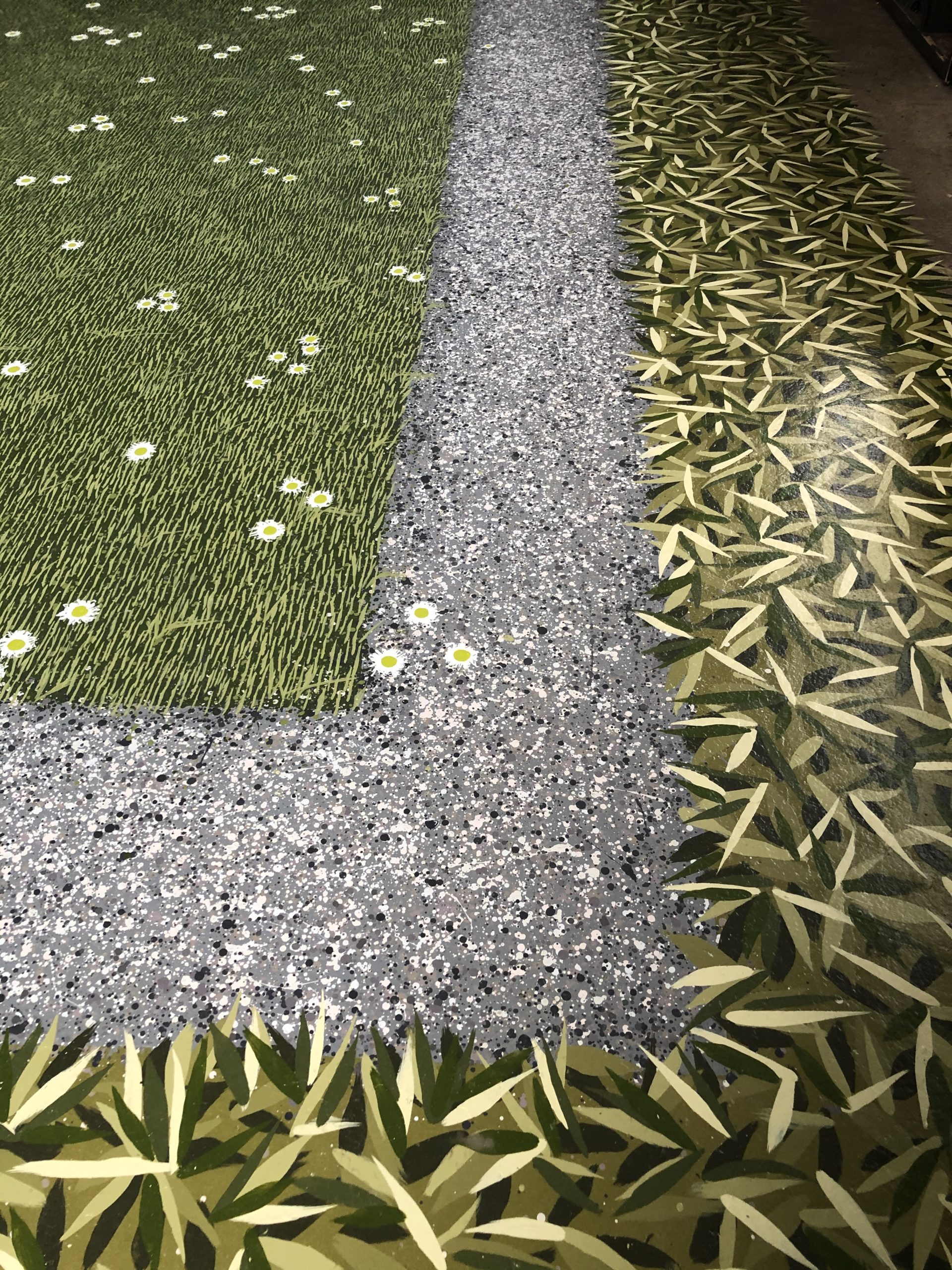
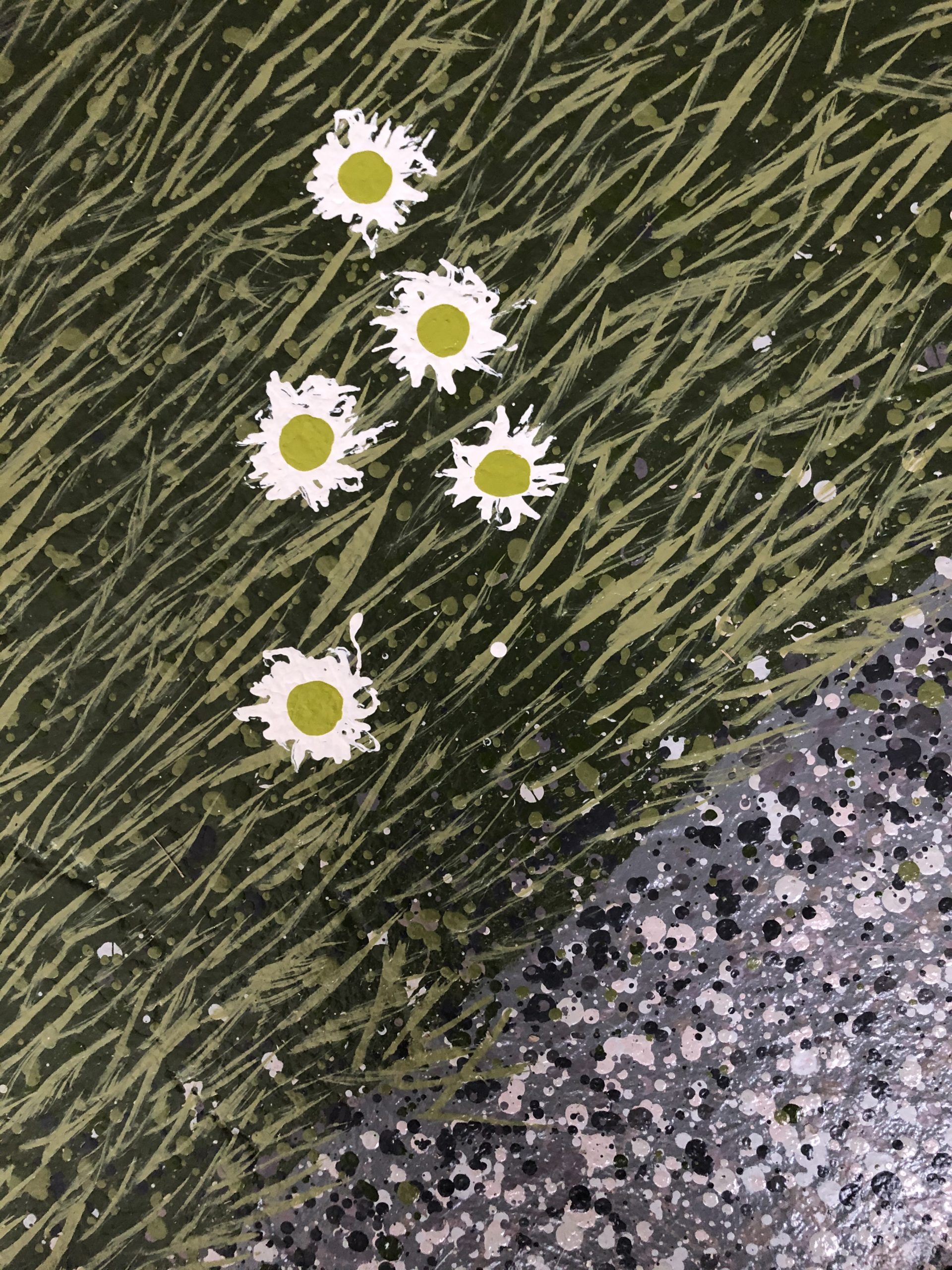
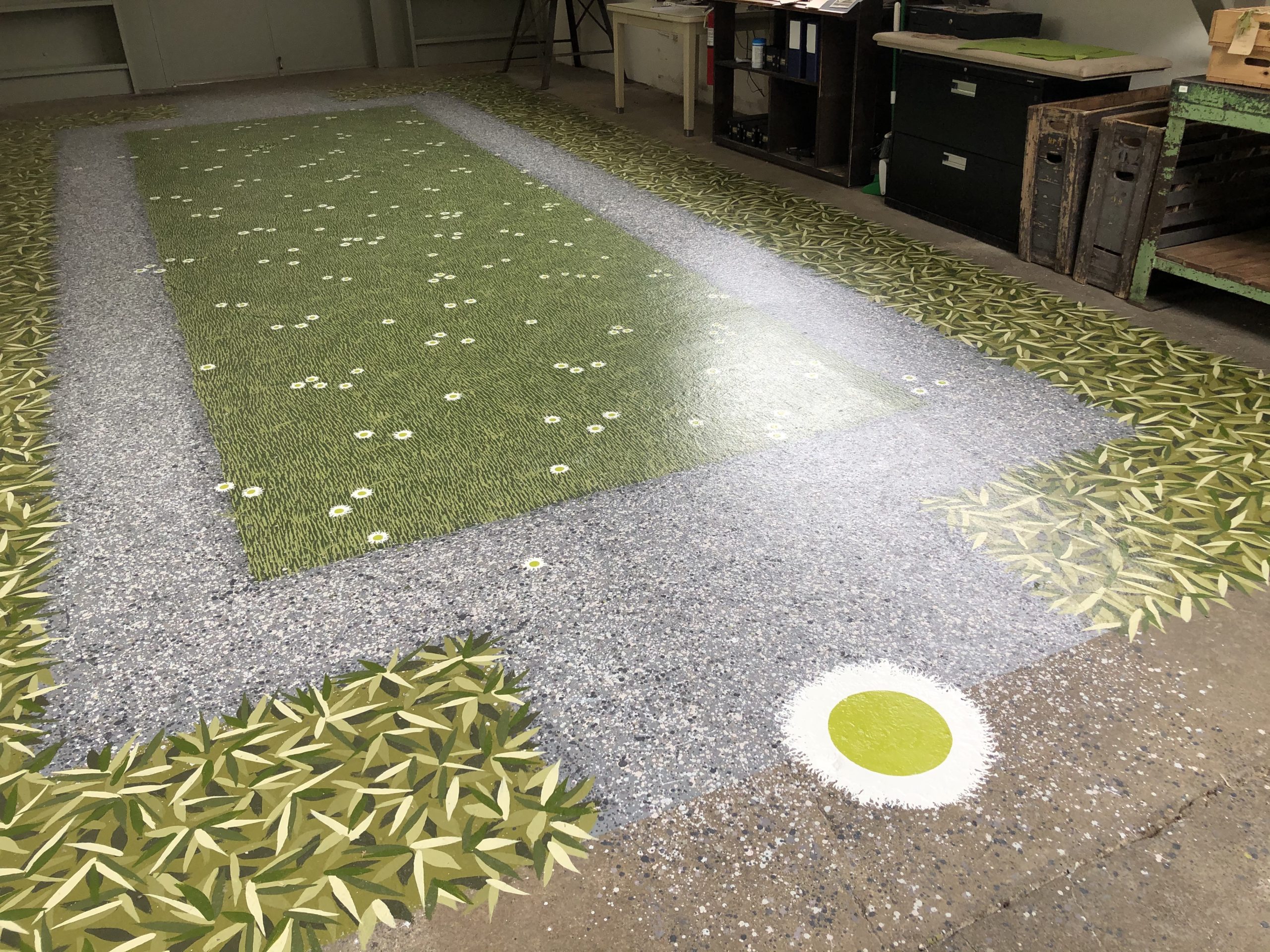
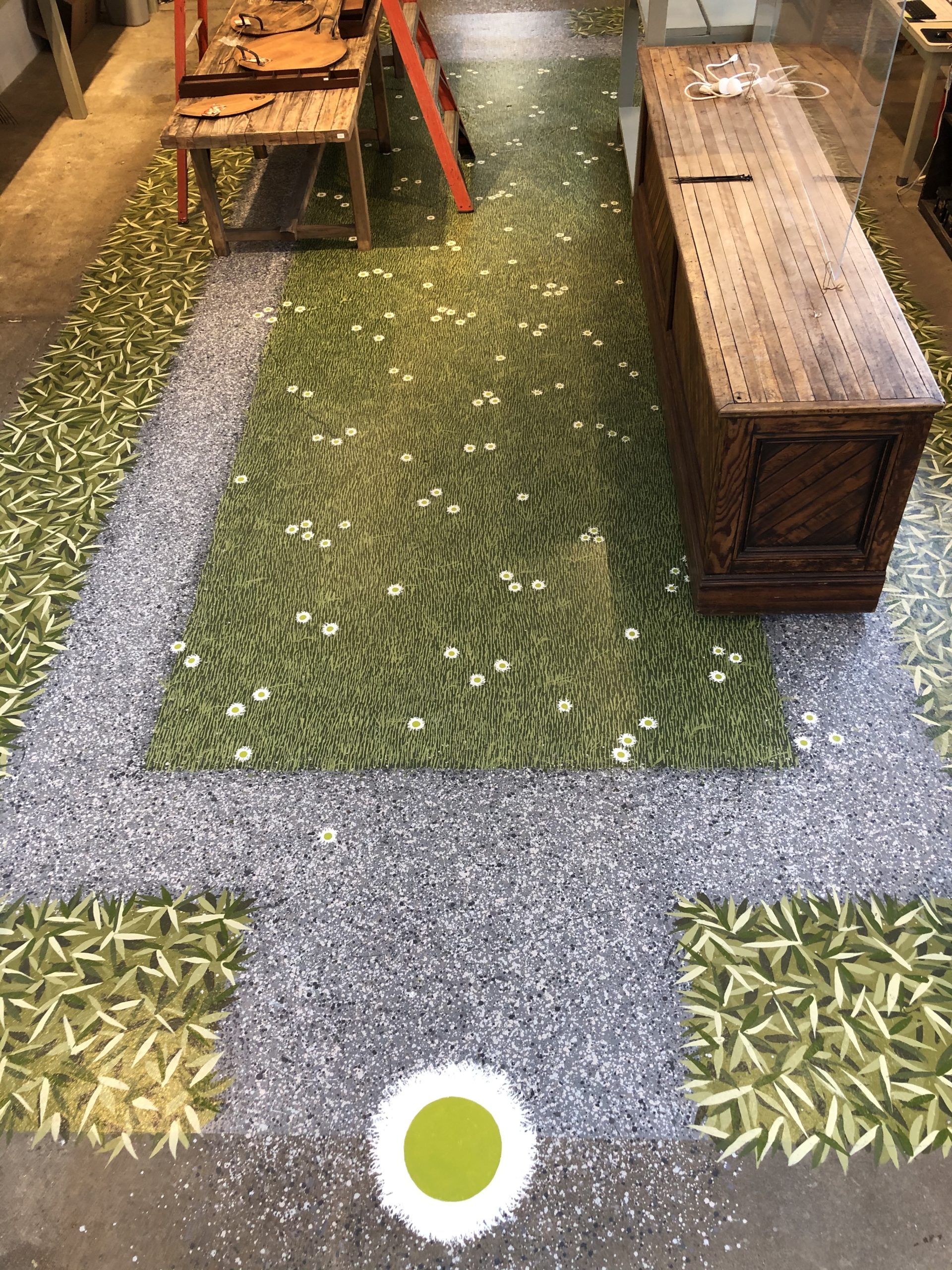

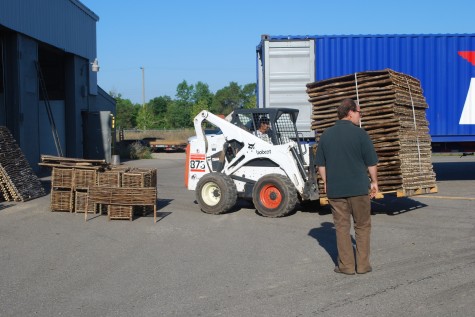 Wattle, or hurdle fencing is a traditional garden or livestock enclosure made from either willow or hazelwood. Last week we took delivery of a forty foot long container of Belgian made fencing. Though I am making a point of shopping my own country, I am especially attracted to Belgian garden ornament. Rob says the Belgian climate and topography is a lot like the Midwest. My most favorite landscape photographer Lynn Geesamon has photographed all over the world. Her images of Belgium so strongly resonate with me, as I do think they remind me of my native landscape. Some of her images can be seen at
Wattle, or hurdle fencing is a traditional garden or livestock enclosure made from either willow or hazelwood. Last week we took delivery of a forty foot long container of Belgian made fencing. Though I am making a point of shopping my own country, I am especially attracted to Belgian garden ornament. Rob says the Belgian climate and topography is a lot like the Midwest. My most favorite landscape photographer Lynn Geesamon has photographed all over the world. Her images of Belgium so strongly resonate with me, as I do think they remind me of my native landscape. Some of her images can be seen at 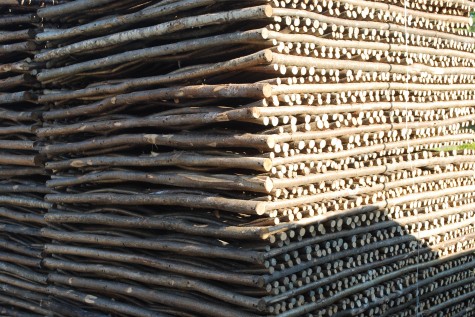 A garden ornament does need to look like it belongs to the garden in which it is placed. It takes some doing to bring these twig structures from their place to mine, but it is worth it. They are heavy, chunky and sturdy-and beautifully constructed. Each five by six foot panel weighs 100 pounds-substantial. We buy peeled cedar fence poles from a company in the upper peninsula of Michigan. This material has a very local feel.
A garden ornament does need to look like it belongs to the garden in which it is placed. It takes some doing to bring these twig structures from their place to mine, but it is worth it. They are heavy, chunky and sturdy-and beautifully constructed. Each five by six foot panel weighs 100 pounds-substantial. We buy peeled cedar fence poles from a company in the upper peninsula of Michigan. This material has a very local feel.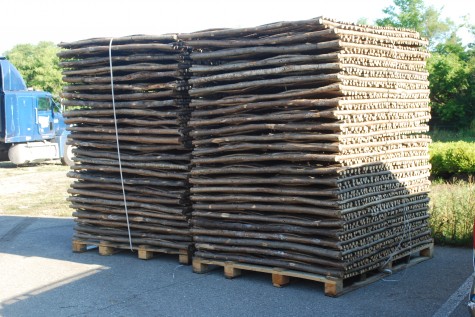
 The woven branches have a great texture, and cast good shadows. The surface is lively and warm. Burt told Rob he sold Italian shoes for 25 years, before opening his twig panel business. It is easy for me to see why he would do this; it must give him great satisfaction to be making objects that celebrate the beauty of the natural world. Rhododendron root furniture, log furniture, twig trellissing-all of these things have a primeval appeal.
The woven branches have a great texture, and cast good shadows. The surface is lively and warm. Burt told Rob he sold Italian shoes for 25 years, before opening his twig panel business. It is easy for me to see why he would do this; it must give him great satisfaction to be making objects that celebrate the beauty of the natural world. Rhododendron root furniture, log furniture, twig trellissing-all of these things have a primeval appeal.
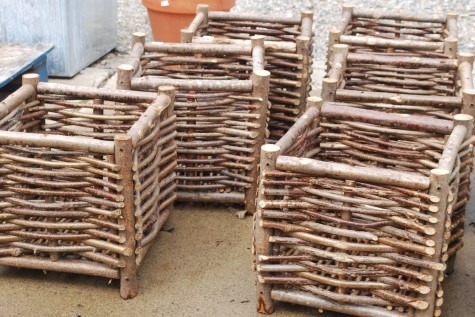
 Positioned with the twigs in the vertical, the panels have a different quality about them-more sculptural and sinuous. I had a client tell me she loves the beauty of ordinary materials. Things people make of ordinary materials can be anything but ordinary. A material like this is just waiting for an inspired placement.
Positioned with the twigs in the vertical, the panels have a different quality about them-more sculptural and sinuous. I had a client tell me she loves the beauty of ordinary materials. Things people make of ordinary materials can be anything but ordinary. A material like this is just waiting for an inspired placement. 